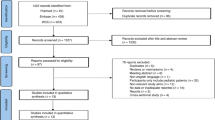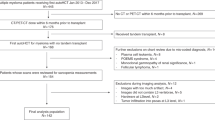Abstract
Accelerated bone mineral density loss (BMDL) occurs early after allogeneic stem cell transplantation (SCT) and is related to factors such as steroids and chronic GvHD. In order to understand the natural history of BMDL of SCT in the longer term, we evaluated a longitudinal cohort of 148 survivors with a median follow-up of 12 years (range 3–22 years). All women received hormone replacement therapy, and routine calcium/vitamin D supplementation was recommended but ∼50% of patients still had suboptimal vitamin D levels and bisphosphonates were rarely utilized. BMD significantly improved from 5 to 20+ years but the femoral neck and forearm remained vulnerable sites. Younger age, higher pretransplant body mass index (BMI) and increment in BMI post transplant were significantly associated with increased BMD and protected against osteopenia/osteoporosis. These findings support consideration of BMD loss in SCT survivors in two phases, an early phase of BMD loss (3–5 years) followed by a later phase of BMD recovery, with different protective and aggravating factors. Treatment- and transplant-related factors (such as steroids, immunosuppressives, chronic GvHD, vitamin D) are known to impact the early phase of BMD loss but age and BMI are more influential in the late phase of BMD recovery.
This is a preview of subscription content, access via your institution
Access options
Subscribe to this journal
Receive 12 print issues and online access
$259.00 per year
only $21.58 per issue
Buy this article
- Purchase on Springer Link
- Instant access to full article PDF
Prices may be subject to local taxes which are calculated during checkout


Similar content being viewed by others
References
Ebeling PR, Thomas DM, Erbas B, Hopper JL, Szer J, Grigg AP . Mechanisms of bone loss following allogeneic and autologous hemopoietic stem cell transplantation. J Bone Miner Res 1999; 14: 342–350.
Schulte C, Beelen DW, Schaefer UW, Mann K . Bone loss in long-term survivors after transplantation of hematopoietic stem cells: a prospective study. Osteoporos Int 2000; 11: 344–353.
Weilbaecher KN . Mechanisms of osteoporosis after hematopoietic cell transplantation. Biol Blood Marrow Transplant 2000; 6: 165–174.
Schulte CM, Beelen DW . Bone loss following hematopoietic stem cell transplantation: a long-term follow-up. Blood 2004; 103: 3635–3643.
De Laet C, Kanis JA, Oden A, Johanson H, Johnell O, Delmas P et al. Body mass index as a predictor of fracture risk: a meta-analysis. Osteoporos Int 2005; 16: 1330–1338.
van der Voort DJ, Geusens PP, Dinant GJ . Risk factors for osteoporosis related to their outcome: fractures. Osteoporos Int 2001; 12: 630–638.
Stern JM, Sullivan KM, Ott SM, Seidel K, Fink JC, Longton G et al. Bone density loss after allogeneic hematopoietic stem cell transplantation: a prospective study. Biol Blood Marrow Transplant 2001; 7: 257–264.
Pundole XN, Barbo AG, Lin H, Champlin RE, Lu H . Increased incidence of fractures in recipients of hematopoietic stem-cell transplantation. J Clin Oncol 2015; 33: 1364–1370.
Valimaki MJ, Kinnunen K, Volin L, Tahtela R, Loyttyniemi E, Laitinen K et al. A prospective study of bone loss and turnover after allogeneic bone marrow transplantation: effect of calcium supplementation with or without calcitonin. Bone Marrow Transplant 1999; 23: 355–361.
Gandhi MK, Lekamwasam S, Inman I, Kaptoge S, Sizer L, Love S et al. Significant and persistent loss of bone mineral density in the femoral neck after haematopoietic stem cell transplantation: long-term follow-up of a prospective study. Br J Haematol 2003; 121: 462–468.
Savani BN, Donohue T, Kozanas E, Shenoy A, Singh AK, Childs RW et al. Increased risk of bone loss without fracture risk in long-term survivors after allogeneic stem cell transplantation. Biol Blood Marrow Transplant 2007; 13: 517–520.
Tauchmanova L, Ricci P, Serio B, Lombardi G, Colao A, Rotoli B et al. Short-term zoledronic acid treatment increases bone mineral density and marrow clonogenic fibroblast progenitors after allogeneic stem cell transplantation. J Clin Endocrinol Metab 2005; 90: 627–634.
Duncan CN, Vrooman L, Apfelbaum EM, Whitley K, Bechard L, Lehmann LE . 25-hydroxy vitamin D deficiency following pediatric hematopoietic stem cell transplant. Biol Blood Marrow Transplant 2011; 17: 749–753.
Faulhaber GA, Premaor MO, Moser Filho HL, Silla LM, Furlanetto TW . Low bone mineral density is associated with insulin resistance in bone marrow transplant subjects. Bone Marrow Transplant 2009; 43: 953–957.
Kanis JA, Gluer CC . An update on the diagnosis and assessment of osteoporosis with densitometry. Committee of Scientific Advisors, International Osteoporosis Foundation. Osteoporos Int 2000; 11: 192–202.
Writing Group for the ISCD Position Development Conference. Diagnosis of osteoporosis in men, premenopausal women, and children. J Clin Densitom 2004; 7: 17–26.
Tauchmanova L, Serio B, Del Puente A, Risitano AM, Esposito A, De Rosa G et al. Long-lasting bone damage detected by dual-energy x-ray absorptiometry, phalangeal osteosonogrammetry, and in vitro growth of marrow stromal cells after allogeneic stem cell transplantation. J Clin Endocrinol Metab 2002; 87: 5058–5065.
Majhail NS, Rizzo JD, Lee SJ, Aljurf M, Atsuta Y, Bonfim C et al. Recommended screening and preventive practices for long-term survivors after hematopoietic cell transplantation. Rinsho Ketsueki 2014; 55: 607–632.
Shuler FD, Conjeski J, Kendall D, Salava J . Understanding the burden of osteoporosis and use of the World Health Organization FRAX. Orthopedics 2012; 35: 798–805.
Chae YS, Kim JG, Moon JH, Kim SN, Lee SJ, Kim YJ et al. Pilot study on the use of zoledronic acid to prevent bone loss in allo-SCT recipients. Bone Marrow Transplant 2009; 44: 35–41.
Tauchmanova L, De Rosa G, Serio B, Fazioli F, Mainolfi C, Lombardi G et al. Avascular necrosis in long-term survivors after allogeneic or autologous stem cell transplantation: a single center experience and a review. Cancer 2003; 97: 2453–2461.
McClune BL, Polgreen LE, Burmeister LA, Blaes AH, Mulrooney DA, Burns LJ et al. Screening, prevention and management of osteoporosis and bone loss in adult and pediatric hematopoietic cell transplant recipients. Bone Marrow Transplant 2011; 46: 1–9.
Yao S, Smiley SL, West K, Lamonica D, Battiwalla M, McCarthy PL Jr et al. Accelerated bone mineral density loss occurs with similar incidence and severity, but with different risk factors, after autologous versus allogeneic hematopoietic cell transplantation. Biol Blood Marrow Transplant 2010; 16: 1130–1137.
McClune B, Majhail NS, Flowers ME . Bone loss and avascular necrosis of bone after hematopoietic cell transplantation. Semin Hematol 2012; 49: 59–65.
Tauchmanova L, De Simone G, Musella T, Orio F, Ricci P, Nappi C et al. Effects of various antireabsorptive treatments on bone mineral density in hypogonadal young women after allogeneic stem cell transplantation. Bone Marrow Transplant 2006; 37: 81–88.
Kananen K, Volin L, Laitinen K, Alfthan H, Ruutu T, Valimaki MJ . Prevention of bone loss after allogeneic stem cell transplantation by calcium, vitamin D, and sex hormone replacement with or without pamidronate. J Clin Endocrinol Metab 2005; 90: 3877–3885.
Kodama M, Komura H, Shimizu S, Hashimoto N, Mitsuda N, Kodama T et al. Efficacy of hormone therapy for osteoporosis in adolescent girls after hematopoietic stem cell transplantation: a longitudinal study. Fertil Steril 2011; 95: 731–735.
Yao S, McCarthy PL, Dunford LM, Roy DM, Brown K, Paplham P et al. High prevalence of early-onset osteopenia/osteoporosis after allogeneic stem cell transplantation and improvement after bisphosphonate therapy. Bone Marrow Transplant 2008; 41: 393–398.
Grigg AP, Shuttleworth P, Reynolds J, Schwarer AP, Szer J, Bradstock K et al. Pamidronate reduces bone loss after allogeneic stem cell transplantation. J Clin Endocrinol Metabol 2006; 91: 3835–3843.
Tauchmanova L, Selleri C, Esposito M, Di Somma C, Orio F Jr, Bifulco G et al. Beneficial treatment with risedronate in long-term survivors after allogeneic stem cell transplantation for hematological malignancies. Osteoporos Int 2003; 14: 1013–1019.
D'Souza AB, Grigg AP, Szer J, Ebeling PR . Zoledronic acid prevents bone loss after allogeneic haemopoietic stem cell transplantation. Intern Med J 2006; 36: 600–603.
Ebeling PR . Approach to the patient with transplantation-related bone loss. J Clin Endocrinol Metab 2009; 94: 1483–1490.
Ganguly S, Divine CL, Aljitawi OS, Abhyankar S, McGuirk JP, Graves L . Prophylactic use of zoledronic acid to prevent early bone loss is safe and feasible in patients with acute myeloid leukemia undergoing allogeneic stem cell transplantation. Clin Transplant 2011; 26: 447–453.
Hari P, DeFor TE, Vesole DH, Bredeson CN, Burns LJ . Intermittent zoledronic acid prevents bone loss in adults after allogeneic hematopoietic cell transplantation. Biol Blood Marrow Transplant 2013; 19: 1361–1367.
Acknowledgements
This work was supported by the Intramural Research Program of the NHLBI, NIH.
Author contributions
PA designed the study, collected data, analyzed and interpreted the data and wrote the manuscript; NAJ and PAP collected data and critically revised the manuscript; XT analyzed and interpreted the data and critically revised the manuscript; COW analyzed the data; BNS critically revised the manuscript; EK and SI took care of patients and critically revised the manuscript; JB and MB designed the study, analyzed and interpreted the data, wrote the manuscript and took care of patients.
Author information
Authors and Affiliations
Corresponding author
Ethics declarations
Competing interests
The authors declare no conflict of interest.
Additional information
Supplementary Information accompanies this paper on Bone Marrow Transplantation website
Supplementary information
Rights and permissions
About this article
Cite this article
Anandi, P., Jain, N., Tian, X. et al. Factors influencing the late phase of recovery after bone mineral density loss in allogeneic stem cell transplantation survivors. Bone Marrow Transplant 51, 1101–1106 (2016). https://doi.org/10.1038/bmt.2016.85
Received:
Revised:
Accepted:
Published:
Issue Date:
DOI: https://doi.org/10.1038/bmt.2016.85
This article is cited by
-
Male-specific late effects in adult hematopoietic cell transplantation recipients: a systematic review from the Late Effects and Quality of Life Working Committee of the Center for International Blood and Marrow Transplant Research and Transplant Complications Working Party of the European Society of Blood and Marrow Transplantation
Bone Marrow Transplantation (2022)
-
Bone turnover markers as an aid to monitor osteoporosis following allogeneic hematopoietic stem cell transplantation
Annals of Hematology (2020)
-
Predictors of impaired bone health in long-term survivors after allogeneic stem cell transplantation
Bone Marrow Transplantation (2019)
-
Bone management in hematologic stem cell transplant recipients
Osteoporosis International (2018)
-
An individualised risk-adapted protocol of pre- and post transplant zoledronic acid reduces bone loss after allogeneic stem cell transplantation: results of a phase II prospective trial
Bone Marrow Transplantation (2017)



